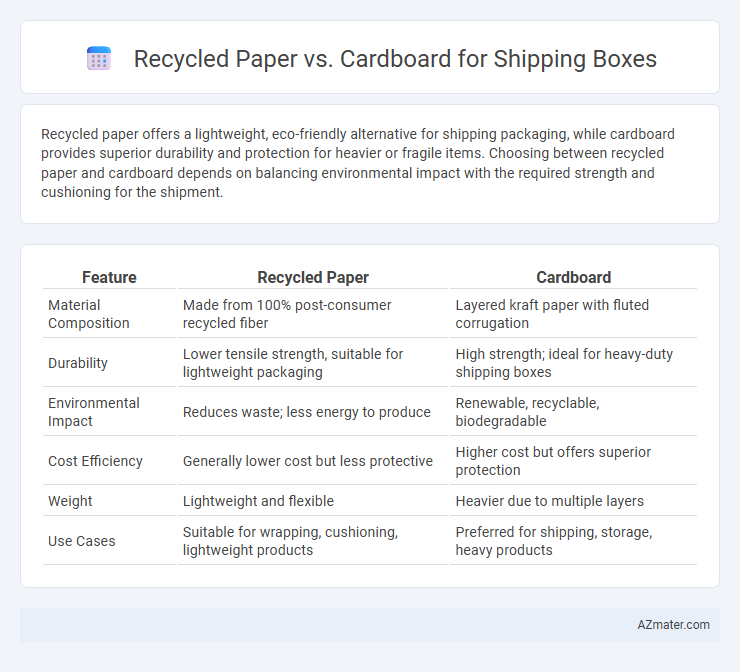Recycled paper offers a lightweight, eco-friendly alternative for shipping packaging, while cardboard provides superior durability and protection for heavier or fragile items. Choosing between recycled paper and cardboard depends on balancing environmental impact with the required strength and cushioning for the shipment.
Table of Comparison
| Feature | Recycled Paper | Cardboard |
|---|---|---|
| Material Composition | Made from 100% post-consumer recycled fiber | Layered kraft paper with fluted corrugation |
| Durability | Lower tensile strength, suitable for lightweight packaging | High strength; ideal for heavy-duty shipping boxes |
| Environmental Impact | Reduces waste; less energy to produce | Renewable, recyclable, biodegradable |
| Cost Efficiency | Generally lower cost but less protective | Higher cost but offers superior protection |
| Weight | Lightweight and flexible | Heavier due to multiple layers |
| Use Cases | Suitable for wrapping, cushioning, lightweight products | Preferred for shipping, storage, heavy products |
Introduction to Sustainable Shipping Materials
Recycled paper and cardboard are essential components in sustainable shipping materials, offering eco-friendly alternatives to conventional packaging. Recycled paper utilizes post-consumer waste to reduce environmental impact, while cardboard provides sturdy, biodegradable protection for shipping goods. Choosing these materials supports waste reduction, resource conservation, and lowers carbon footprints in the supply chain.
What is Recycled Paper?
Recycled paper is made from used paper products that have been collected, processed, and reformed into new paper materials, reducing the need for virgin pulp and conserving natural resources. This sustainable material retains durability and strength suitable for various packaging applications, including shipping boxes when combined with other fibers for reinforcement. Using recycled paper in shipping boxes helps minimize environmental impact by decreasing waste and lowering carbon emissions compared to products made from fresh wood fibers.
What is Cardboard?
Cardboard, a durable material primarily composed of cellulose fibers, is widely used for shipping boxes due to its strength and protective qualities. It typically comes in corrugated form, consisting of a fluted corrugated sheet sandwiched between two flat linerboards, which enhances its rigidity and impact resistance. Unlike recycled paper that may vary in quality, cardboard provides reliable cushioning and structural support, making it ideal for safeguarding items during transit.
Key Differences Between Recycled Paper and Cardboard
Recycled paper is made from processed waste paper fibers and is typically thinner, making it suitable for lightweight packaging and wrapping materials, whereas cardboard is a thicker, sturdier paper-based product often used for shipping boxes due to its enhanced durability and cushioning properties. Cardboard generally consists of multiple layers, such as corrugated fiberboard with fluted middle layers providing extra strength, unlike recycled paper which tends to be a single-layer material. The environmental benefits of both include reduced deforestation and landfill waste, but cardboard's structural integrity makes it the preferred choice for protecting heavier or fragile items during transit.
Environmental Impact: Recycled Paper vs Cardboard
Recycled paper and cardboard both reduce environmental impact by minimizing landfill waste and conserving natural resources, but recycled cardboard typically offers greater durability and reusability, leading to fewer packaging replacements. The production of recycled cardboard consumes less energy and water compared to virgin cardboard, significantly lowering carbon emissions associated with shipping boxes. Choosing recycled cardboard over recycled paper for shipping boxes enhances sustainability due to its higher post-consumer recycled content and improved biodegradability in waste management systems.
Durability and Protection in Shipping
Recycled paper, while eco-friendly, generally offers lower durability and protection compared to cardboard when used for shipping boxes. Cardboard provides superior structural strength, cushioning, and resistance to moisture, making it more reliable for protecting goods during transit. Enhanced corrugated cardboard variants combine recycled content with robust construction, ensuring optimal durability and safeguarding fragile items effectively.
Cost Effectiveness Comparison
Recycled paper shipping boxes generally offer greater cost effectiveness due to lower raw material expenses and reduced manufacturing energy requirements compared to cardboard. Cardboard, while often providing superior durability, tends to be more expensive because of thicker material and additional processing involved. Companies prioritizing budget efficiency often choose recycled paper options for lightweight or less fragile items, balancing cost savings with adequate protection.
Customization and Design Flexibility
Recycled paper offers higher customization and design flexibility for shipping boxes due to its smoother surface, allowing for detailed printing, vibrant colors, and intricate branding elements. Cardboard, while sturdy and protective, typically has a rougher texture that limits high-resolution graphics and complex design variations. Businesses seeking unique, visually appealing packaging often prefer recycled paper for its ability to support advanced personalization and creative packaging solutions.
Common Applications in Shipping Industry
Recycled paper and cardboard both serve essential roles in the shipping industry, with cardboard predominantly used for durable outer packaging due to its strength and cushioning properties. Recycled paper is commonly utilized for void fill, wrapping fragile items, and protective layering inside shipping boxes, enhancing sustainability without compromising protection. The choice between recycled paper and cardboard often depends on the shipment's weight, fragility, and environmental impact goals.
Choosing the Right Material for Your Shipping Needs
Recycled paper offers lightweight and eco-friendly cushioning ideal for protecting delicate items, while cardboard provides sturdy structure and durability essential for heavy or bulky shipments. Choosing the right material depends on the weight, fragility, and shipping distance of your products, with recycled paper minimizing waste and cardboard maximizing protection. Businesses prioritizing sustainability and cost-efficiency often combine both materials to optimize packaging strength and environmental impact.

Infographic: Recycled paper vs Cardboard for Shipping box
 azmater.com
azmater.com